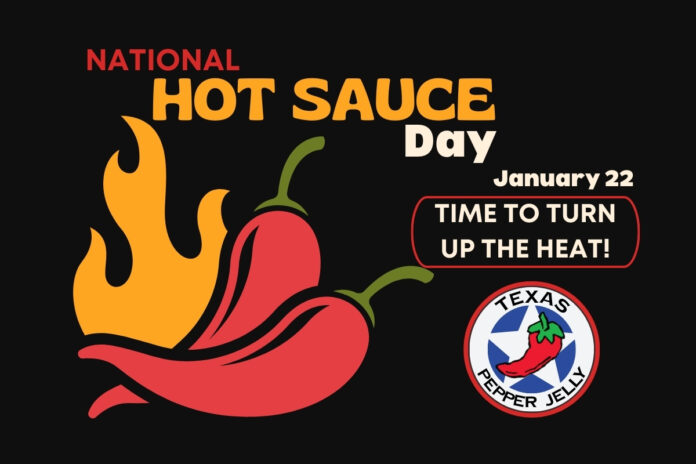National Hot Sauce Day, celebrated annually on January 22, offers a spicy opportunity to delve into hot sauces. This day is not just about indulging in fiery flavors; it’s a celebration of the diverse and rich history of hot sauces globally. According to a 2022 Instacart-Harris poll, 74% of Americans like hot sauce on their food. If you’re a fan of this pungent condiment, you’ll love this post. Here are some interesting facts about hot sauce, including its history, the Scoville heat grading scale, and where you can find our favorite hot sauce (hint: you can buy it here)! Let’s get to it.
History of Hot Sauce
Like many national food holidays, the true origins of National Hot Sauce Day have yet to be discovered. That said, the fact that there is a National Hot Sauce indicates those behind the food holiday really like the stuff. What we do know is the history of hot sauce itself. You have no hot sauce without chili peppers, but thanks to the Aztecs and Mayans, we have both!
Hot Sauce Day Celebrations
We found festivals around the country that highlight the chili pepper, the foundation of hot sauce. So, in honor of the beloved chili pepper, here are a few celebrations taking place in 2024:
- Jan. 20: Hops n’ Hot Sauce Festival, Humble, TX
- March 1 – 3: National Fiery Foods & BBQ Show, Albuquerque, NM
- April 27 – 28: The Boston Sauce Party, Boston, MA
- May 24 – 26: ZestFest 2024, Forth Worth, TX
- Aug. 16 – 18: North Hudson Pepper Fest, Hudson, WI
- Sept. 6 – 7: Chili Pepper Festival, Bowers PA
- Sept. 20 – 24: Pueblo Chile & Frijoles Festival, Pueblo, CO
- Sept. 27 – 28: Chili Pepper Cross Country Festival, Fayetteville, AR
- Oct. 26: Hot Pepper Festival, Palestine, TX
Although our list is not exhaustive, you won’t have trouble finding chili festivals around the country and world listed online.
Hot Sauce Health Benefits
As if throwing a party for hot sauce wasn’t enough. Many tout the health benefits of hot sauce. According to Healthline, since hot sauce is typically used in small amounts, it contains few calories, vitamins, and minerals. However, it does contain a small amount of Vitamin C. The real health hero of hot sauce is capsaicin, a chili pepper extract. Over the centuries since its humble beginnings, research has shown capsaicin may prove helpful in areas such as pain relief, weight loss, decreasing inflammation, and cancer prevention. While we are all for giving your food a good splash of hot sauce, it’s important to know that touching capsaicin can leave people with a burning sensation on their skin, acid reflux, or stomach cramps when consumed. For this reason, if you’re new to partaking in hot sauce, start with a tiny amount and work your way up.
Bring On the Heat
So, how do you know how hot a bottle of hot sauce is without tasting it? Check the bottle for what type of peppers it contains or if it has a Scoville heat grading scale score, as noted with flames!
The Scoville scale measures the pungency, or spiciness (based on the concentration of capsaicin) of hot food like peppers. Capsaicin produces a burning sensation when it touches your tongue or skin.
Wilbur Scoville, a pharmacist, created the Scoville scale in 1912. He was interested in what it would take for tasters to no longer detect any heat from capsaicin. This required him to add capsaicin (from a single pepper) to increasingly larger amounts of sugar water until most of the tasters could no longer feel the capsaicin burn. How much sugar water it took to render the capsaicin tasteless determined the pepper’s number of Scoville Heat Units (SHU)
The hottest pepper in the world is the Carolina Reaper. This pepper rings in around 1.5 – 2 million SHUs. Not sure how that relates to the rest of his pepper cousins? Your everyday bell pepper has no SHUs; Poblano contains about 1,000 to 1,500, Jalapenos 2,500 – 8,000, Cayennes jump to 30,000 – 50,000. Habaneros are even hotter at 100,00 – 350,000 SHUs — still considerably mild compared to 1.5 -2 million!
So, where do some well-known hot sauces fall on the Scoville scale?
- Frank’s 450 SHUs
- Tabasco 2,500 SHUs
- Cholula 3,600 SHUs
- Da Bomb Beyond Insanity 135,000 SHUs
- Dingo Widow Maker 682,000 SHUs



 Our favorite, Craig’s Hot Sauce, made with Ghost peppers, has around 1,000,000+ SHUs. Keep in mind that many factors go into determining a pepper’s heat, including the seeds’ lineage, soil composition, and overall climate. The most important factor is one’s tolerance of the capsaicin. A pepper one person considers mild; another may find flaming hot.
Our favorite, Craig’s Hot Sauce, made with Ghost peppers, has around 1,000,000+ SHUs. Keep in mind that many factors go into determining a pepper’s heat, including the seeds’ lineage, soil composition, and overall climate. The most important factor is one’s tolerance of the capsaicin. A pepper one person considers mild; another may find flaming hot.
If you want to check out where other peppers lie on the scale, you can do so here.

